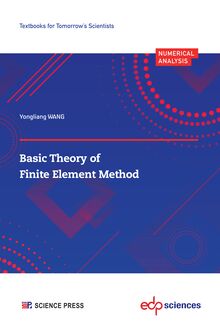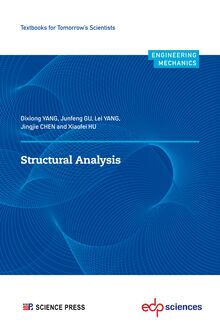Structural Analysis , livre ebook
440
pages
English
Ebooks
2023
Obtenez un accès à la bibliothèque pour le consulter en ligne En savoir plus
Découvre YouScribe en t'inscrivant gratuitement
Découvre YouScribe en t'inscrivant gratuitement
440
pages
English
Ebooks
2023
Obtenez un accès à la bibliothèque pour le consulter en ligne En savoir plus
Publié par
Date de parution
12 décembre 2023
Nombre de lectures
1
EAN13
9782759831913
Langue
English
Poids de l'ouvrage
29 Mo
Structural Analysis is a basic course for undergraduate students with majors of civil engineering, engineering mechanics, flight vehicle design, mechanical engineering, naval architecture and ocean engineering etc., and is also an introductory course for undergraduates to learn and master the analysis and design of beam, truss, frame, arch and composite structures for buildings, bridges and flight vehicles and so on.
This textbook includes eight chapters, and covers introduction, kinematic analysis of plane member systems, analysis of statically determinate structures, principle of virtual work and deflection calculation, force method, displacement method, influence lines of structures under moving loads, and matrix displacement method.
Main features of this textbook lie in:
(1) strengthened the interestingness and readability, and increased brief introduction on the developmental history of structural analysis and the important figures;
(2) adopted the kinematic method to construct exactly and rapidly the influence lines of forces of statically indeterminate structures proposed by the author, and highlighted the energy principles and methods;
(3) increased introducing the backgrounds of engineering applications;
(4) from the viewpoints of history, methodology, aesthetic appreciation and creative thinking, inspected structural analysis and strived to cultivate the innovative talents.
This book is designed to serve as a textbook for students in fields such as civil engineering, engineering mechanics, flight vehicle design, mechanical engineering, and ocean engineering, as well as a helpful reference for engineers and professionals in related fields.
Brief Introduction to the Book................................... III
About the Authors............................................ V
Preface..................................................... VII
Notations................................................... XV
CHAPTER 1
Introduction................................................. 1
1.1 Research Object and Tasks of Structural Analysis................ 2
1.1.1 Research Object.................................... 2
1.1.2 Tasks............................................ 3
1.2 Computational Models of Structures.......................... 4
1.2.1 Simplification of Structural Systems..................... 5
1.2.2 Simplification of Members............................ 5
1.2.3 Simplification of Joints............................... 6
1.2.4 Simplification of the Supports......................... 7
1.2.5 Simplification of Material Properties..................... 8
1.2.6 Simplification of Loads............................... 8
1.3 Classification of Member Structures and Loads .................. 10
1.3.1 Classification of Member Structures..................... 10
1.3.2 Classification of Loads............................... 11
1.4 A Brief History of the Development of Structural Analysis ......... 12
1.4.1 Energy Principles and Energy Methods.................. 13
1.4.2 Force Method and Displacement Method................. 15
1.4.3 Matrix Displacement Method and Finite Element Method .... 18
1.5 A Brief Introduction to Important Figuresin Structural Analysis .... 20
CHAPTER 2
Kinematic Analysis of Plane Member Systems....................... 27
2.1 Several Concepts of Kinematic Analysis....................... 28
2.1.1 Degree of Freedom and Constraint...................... 28
2.1.2 Instantaneously Changeable System and Constantly Changeable System................................. 30
2.1.3 Instantaneous Hinge................................. 31
2.2 Basic Construction Rules of Plane Geometrically Unchangeable Systems............................................... 32
2.2.1 The Rule of Pin-Joined Member System.................. 32
2.2.2 The Rule of Two Rigid Discs.......................... 33
2.2.3 The Rule of Three Rigid Discs......................... 34
2.3 Computational Degree of Freedom of Plane Member Systems ....... 39
2.3.1 Computational Degree of Freedom of Rigid Disc System ...... 40
2.3.2 Computational Degree of Freedom of the Hinged System ..... 42
2.3.3 Computational Degree of Freedom of the Mixed System ...... 44
2.4 Geometrical Stability and Static Determinacy of Systems .......... 45
Problems................................................... 46
CHAPTER 3
Analysis of Statically Determinate Structures........................ 49
3.1 Single-Span Statically Determinate Beams..................... 50
3.1.1 Single-Span Statically Determinate Beamsand Internal Forces........................................... 50
3.1.2 Relations Between Loads and Internal Forces .............. 52
3.1.3 Method of Segmental Superposition..................... 54
3.2 Multi-Span Statically Determinate Beams...................... 57
3.3 Statically Determinate Plane Trusses......................... 62
3.3.1 Characteristics and Classification of Trusses ............... 62
3.3.2 Method of Joints................................... 64
3.3.3 Method of Sections.................................. 67
3.3.4 Combined Application of the Method of Joints
and the Method of Sections........................... 69
3.4 Statically Determinate Plane Frames.......................... 71
3.4.1 Characteristics of Frames............................. 71
3.4.2 Calculation of Support Reactions....................... 71
3.4.3 Internal Force Analysis and DrawingInternal Force Diagram of Frames.................................. 75
3.4.4 Quick Drawing of Moment Diagrams of Statically Determinate Frames................................. 84
3.5 Statically Determine Composite Structures..................... 86
3.6 Three-Hinged Arches..................................... 92
3.6.1 Support Reactions and Internal Force Calculation of Three-Hinged Arches.............................. 93
3.6.2 Rational Axes of Three-Hinged Arches................... 99
3.7 General Properties of Statically Determinate Structures ........... 104
Problems................................................... 106
CHAPTER 4
Principle of Virtual Work and Deflection Calculation .................. 113
4.1 Overview of Deflection Calculation........................... 113
4.1.1 Concept of Structural Displacements.................... 113
4.1.2 Purpose of Deflection Calculation....................... 115
4.2 Principle of Virtual Work for Deformable Structures .............. 116
4.2.1 Principle of Virtual Work for Rigid Body System ........... 116
4.2.2 Application Conditions of Principle of Virtual Work for Deformable Structures............................ 116
4.2.3 Virtual Work Equation for Deformable Structures .......... 119
4.2.4 Principle of Virtual Forces and Principle of Virtual Displacements..................................... 122
4.3 Unit-Load Method for Structural Deflection Calculation ........... 124
4.4 Deflection Calculation under Loads........................... 127
4.4.1 Formula for Deflection Calculation under Loads ............ 127
4.4.2 Deflection Formulas for Various Structures ................ 128
4.4.3 Examples of Deflection Calculation under Loads............ 130
4.5 Graph Multiplication Method............................... 136
4.5.1 Graph Multiplication Method and Its Application Conditions. . 136
4.5.2 Several Specific Problems of Applying Graph Multiplication Method.......................................... 137
4.5.3 Examples of Graph Multiplication Method................ 140
4.6 Deflection Calculation under Temperature Change ............... 143
4.7 Reciprocal Theorems of Linearly Elastic Structures ............... 146
4.7.1 Theorem of Reciprocal Works.......................... 146
4.7.2 Theorem of Reciprocal Displacements.................... 148
4.7.3 Theorem of Reciprocal Reactions....................... 149
4.7.4 Theorem of Reciprocal Displacement-Reaction ............. 150
Problems................................................... 151
CHAPTER 5
Force Method................................................ 157
5.1 Determination of Degree of Static Indeterminacy ................ 158
5.1.1 Equilibrium and Geometric Construction Characteristics of Statically Indeterminate Structures.................... 158
5.1.2 Determination of Degree of Indeterminacy and Number of Redundant Constraint Forces........................ 159
5.2 Fundamental Concept of the Force Method..................... 161
5.2.1 Primary Unknowns, Primary System, and Basic Equations of Force Method.................................... 161
5.2.2 Analysis of Structures with Multiple Degrees of Indeterminacy by Force Method................................... 165
5.2.3 Canonical Equations of Force Method................... 167
5.3 Analysis of Statically Indeterminate Framesand Bent Structures .... 169
5.4 Analysis of Statically Indeterminate Trusses and Composite Structures.............................................. 177
5.5 Analysis of Symmetric Structures and Half Structures............. 182
5.5.1 Selection of Symmetric Primary System.................. 184
5.5.2 Determination of Half Structure in Terms of Symmetry ...... 188
5.6 Two-Hinged and Hingeless Arches............................ 193
5.6.1 Solving Two-Hinged Arch by the Force Method ............ 194
5.6.2 Solving Hingeless Arch by the Force Method .............. 200
5.7 Internal Force Analysis of Structures under Support Movement or Temperature Change................................... 204
5.7.1 Support Movement.................................. 204
5.7.2 Temperature Change................................ 208
5.8 Deflection Computation of Statically Indeterminate Structures ...... 210
5.9 Check for Calculated Results of Statically Indeterminate Structures . . 215
5.9.1 Check of Equilibrium Conditions....................... 216
5.9.2 Check of Deformation Conditions....................... 217
Problems................................................... 218
CHAPTER 6
Displacement Method.......................................... 223
6.1 Fundamental Concept of the Displacement Method ............... 224
6.1.1 A Simple Example of Displacement Method............... 224
6.1.2 Primary Unknowns and Basic Equations of Displacement Method.............................. 227
6.1.3 Basic Idea of Calculating Frame Structures by Displacement Method............................. 228
6.1.4 Determination of Primary Unknowns of Displacement Method . 229
6.2 Slope-Deflection Equation of Prismatic Member ................. 232
6.2.1 Calculating Member-End Internal Forces from Member-End Displacements..................................... 234
6.2.2 Calculating Fixed-End Internal Forces from Loads .......... 238
6.3 Analysis of Frames Without Sidesway......................... 241
6.3.1 Selection of Primary Unknowns........................ 241
6.3.2 Establishment of Basic Equations....................... 241
6.4 Analysis of Frames with Sidesway............................ 245
6.5 Analysis of Symmetric Structures............................ 253
6.6 Primary System in the Displacement Method................... 256
6.6.1 Primary System of the Displacement Method.............. 257
6.6.2 Basic Equations of the Displacement Method .............. 258
6.6.3 Process of Establishing the Basic Equations of the Displacement Method........................... 260
6.6.4 Canonical Equations of Displacement Method ............. 262
6.7 Principle of Potential Energy and Displacement Method ........... 264
6.7.1 Principle of Stationary Potential Energy.................. 264
6.7.2 Linear Elastic Strain Energy of Prismatic Member .......... 266
6.7.3 Principle of Potential Energy and Equilibrium Equation of Displacement Method.............................. 267
6.8 Rayleigh–Ritz Method.................................... 272
6.9 Moment-Distribution Method and No-Shear Distribution Method .... 274
6.9.1 Basic Principle of the Moment-Distribution Method ......... 275
6.9.2 Computation of Continuous Beams and Frames Without
Sidesway Using the Moment-Distribution Method.......... 280
6.9.3 No-Shear Distribution Method......................... 286
6.10 Characteristics of Statically Indeterminate Structures ............. 292
Problems................................................... 294
CHAPTER 7
Influence Lines for Structures under Moving Loads .................... 301
7.1 Concepts of Moving Load and Influence Line................... 302
7.2 Equilibrium Method for Constructing Influence Lines of Simply Supported Beams........................................ 304
7.3 Influence Lines for Girders and Trusses........................ 309
7.3.1 Influence Lines for Internal Forces of Girders .............. 309
7.3.2 Influence Lines for Axial Forces of Trusses ................ 311
7.4 Kinematic Method for Constructing Influence Lines of Statically Determinate Structures.................................... 315
7.5 Applications of Influence Lines.............................. 321
7.5.1 Responses Due to Various Kinds of Loads................ 322
7.5.2 Most Unfavorable Position of Moving Loads............... 324
7.5.3 Determination of Critical Position forPolygonal Influence Line............................................. 326
7.5.4 Determination of Critical Position for Triangle Influence Line . . 330
7.6 Kinematic Method for Constructing Influence Lines of Statically
Indeterminate Beams..................................... 333
Problems................................................... 341
CHAPTER 8
Matrix Displacement Methods................................... 345
8.1 Fundamental Principle of the Matrix Displacement Method ........ 346
8.2 Elemental Stiffness Matrix................................. 347
8.2.1 Elemental Stiffness Matrix in Local Coordinate System ...... 348
8.2.2 Properties of Elemental Stiffness Matrix.................. 350
8.3 Coordinate Transformation of Elemental Stiffness Matrix .......... 351
8.3.1 Elemental Stiffness Matrix in the Global Coordinate System ... 351
8.3.2 Elemental Stiffness Matrix of Continuous Beam ............ 355
8.3.3 Elemental Stiffness Matrix of Axial Force Bar.............. 357
8.4 Global Stiffness Matrix of Structure.......................... 360
8.4.1 Element and Node Numberings........................ 360
8.4.2 Direct Stiffness Method for Assembling Global Stiffness Matrix........................................... 362
8.4.3 Imposing Support Conditions.......................... 364
8.4.4 Properties of Global Stiffness Matrix.................... 365
8.4.5 Treatment of Pinned Joints........................... 366
8.5 Equivalent Nodal Loads................................... 366
8.5.1 Basic Equation of Matrix Displacement Method ............ 366
8.5.2 Equivalent Nodal Loads of Elements.................... 367
8.5.3 Equivalent Nodal Loads of Structure.................... 369
8.6 Computational Procedures and Examples...................... 372
8.6.1 Example of Truss Analysis............................ 373
8.6.2 Example of Frame Structure........................... 378
8.6.3 Example of Composite Structure....................... 384
8.6.4 Matrix Displacement Method for Rectangular Frame Neglecting Axial Deformation.......................... 388
Problems................................................... 391
Bibliography................................................. 397
Appendix A1. Answers to Problems............................... 399
Appendix A2. Index........................................... 407
Appendix A3. Matlab Program Codes of the Matrix Displacement Method for Plane Structural Analysis......................... 409
Publié par
Date de parution
12 décembre 2023
Nombre de lectures
1
EAN13
9782759831913
Langue
English
Poids de l'ouvrage
29 Mo


